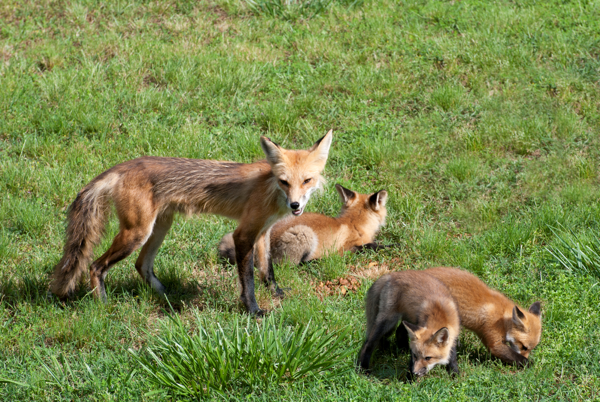How to Get Rid of Foxes

Our licensed technicians have the knowledge and tools for proper fox removal from your property. If you are worried about foxes potentially returning to your property and posing a threat to your pets, it may be time to get in touch with Varment Guard.
At Varment Guard, we care about serving you. We are passionate about providing our customers with the most professional, updated, and innovative techniques for fox control and removal. To learn more about our wildlife removal services, take a look at our Wildlife Removal & Trapping page.
Common Name: Red Fox / Gray Fox
Scientific Name: Vulpes vulpes / Urocyon cinereoargenteus
Fox Reproduction and Life Cycle
Male and female red foxes begin to pair up in December or January. Evidence suggests that red foxes do pair up with the same mates of the past year.
Mating is commonly accomplished in January and the litter is born approximately 52 days later, usually in mid-March, in an underground den. The average litter size for red foxes is 6 to 8 pups. Fox dens are often abandoned woodchuck or badger diggings, which are then renovated by foxes.
The first week after birthing, the female stays in the den with the newborn pups while the male brings food to them. Later on, both mates hunt to provide food for the litter.

HOW TO GET RID OF FOXES:
Live-Trapping
Most often foxes can be captured in live catch wire traps. These are baited with fish, peanut butter, cat food, and some fruit paste baits. Some foxes are very clever and difficult to capture so the use of a dirt set trap is required. Set traps are a staked leg-hold trap type (strategically placed to avoid humans and non-target animals). Another proven method for taking trap shy foxes is through the strategic placement of snares concealed among tall vegetation and brush along trails.
Exclusion
For foxes denning under decks, sheds, or any structure, the best exclusion method is buried wire. Varment Guard's wildlife control experts will survey your property and present the best control method available.
FOX BIOLOGY
- Adult body length (without tail): 16 to 29 inches
- Adult body weight: 7 to 15 pounds
- Gestation period: 51 to 63 days
- Litters per year: 1
- Litter size: 3 to 9 young (usually 3 to 7)
- Breeding season: January through February
- Birthing season: March through April
- Age at which young are weaned: 6 to 7 weeks
- Activity period: Night (pre-sunset to post-dawn)
- Range: 3 to 25 square miles
- Primary foods: Rabbits, rodents, birds, eggs, small livestock, insects, fruits

FOX: DANGER & DAMAGE
Foxes prey on turkeys, chickens, ducks, geese, pheasants and the eggs of these birds. They also prey on young pigs, lambs and small dogs and cats. Foxes also carry rabies.
Like coyotes, foxes often move from outlying rural areas into more urbanized settings in search of suitable harborage and prey.
Foxes can cause trouble for chicken farmers and small pet owners. However, foxes, for the most part, are not a threat to humans. But they are canines that should only be handled by a professional fox trapper or fox removal specialist. Foxes can carry several different types of diseases including rabies and canine distemper—they also have razor sharp teeth.
Humane Fox Control and Treatment Near You
Red fox populations can vary from state to state and county to county. Rural foxes have been pushed more and more into urban areas by coyotes. Foxes can often be found living under decks, sheds, wood piles, and even under children’s playhouses.
As cool as foxes look, you should give us a call and have the fox near you trapped and removed for healthy and safety reasons. Never corner a fox or try to handle it. If you’re having a fox problem and need it trapped, give Varment Guard a call! One of our licensed fox removal specialists will assist you in humanely removing foxes from your property.







